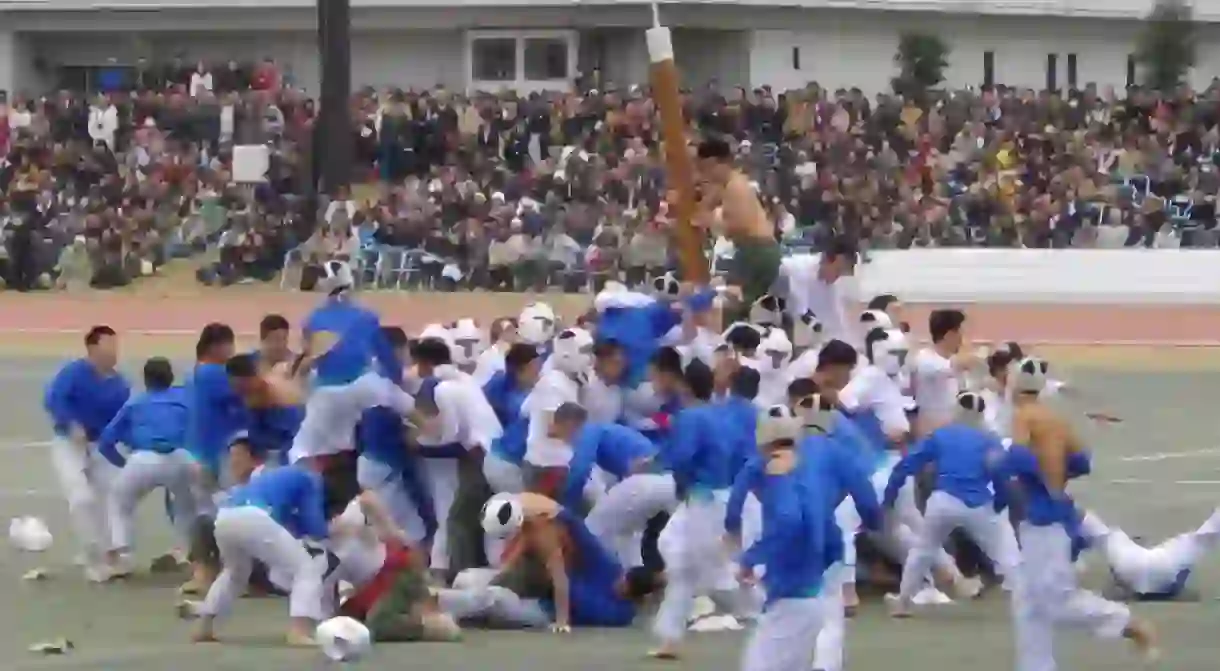Bo-taoshi: Japan's Brutal Pole Toppling Game

As the 2020 Tokyo Olympics appear on the horizon, behold a sport that undoubtedly won’t appear on the program, but definitely will capture the imagination of those who seek something a little bit different – and a little bit chaotic.
Introduction to Bo-taoshi
Have a look at the video clip below. What are the first words that come to mind?
If they fall somewhere within the region of ‘speed’, ‘chaos’ and ‘aggression’, you’d be hard-pressed to find someone that disagrees. Bo-taoshi (棒倒し), literally translated as ‘pole bring-down’, is essentially a Japanese version of Capture the Flag, except for a few slight fundamental differences…
1.
The ‘flag’ is a pole.
2.
The offence needs to hang off of said pole to bring it down.
3.
They will most likely have to kick several defenders in the face just to get to the pole.
The result is a true spectacle of a sport; a car crash that demands the crowd’s attention despite the wreckage. It is a hotly contested, traditional game that taps into the same morbid curiosity that keeps sports fans coming back to the more popular combat sports, such as American football, mixed martial arts and boxing.

The mystery of Bo-taoshi
Bo-taoshi’s history and tradition is shrouded in mystery, with many aspects of its origin serving as a topic for debates almost as fierce as the sport itself. It is thought that the sport was first played in 1945 by the Japanese militia, as a way of preparing them for battle in a tumultuous period for the country. This would explain why the National Defense Academy of Japan’s new cadets play bouts of Bo-taoshi as part of the institution’s famous annual induction ceremony. Unbelievably, kids and teenagers also play the sport on special occasions, such as sports days and cultural holidays.

How is Bo-taoshi played?
From what is known of the sport, a single contest involves two teams of 150 players. Yes, that wasn’t a typo – 150 players. Each team is split into half to make up the offensive and defensive units. As the footage suggests, both defences are distinguishable by their white garments, whereas the offensive units tend to wear bright colours, to prevent as much confusion as possible. After a series of rituals involving choreographed jumping and boisterous chants, the defensive group position themselves around (and on) the pole, before raising their hands to signal they are ready for the onslaught. At the sound of gunfire, the opposing offensive team begins their assault, quite literally throwing themselves at the other team.

Method in the madness
Despite the scrum of noise and flailing limbs, there is actually a strategy to the sport, with various participants adopting specialist positions to aid their team’s quest using brutal efficiency.
On the defensive side, there are five key positions:
1.
Interference – Unsurprisingly, this role is literal, with the objective being to prevent any opposing attackers from reaching the pole, after breaching the first line of defence.
2.
Barrier – The crowd of defenders that converge around the pole to protect it.
3.
Pole Support – Their role is to keep the pole upright (even if the opposition is hanging off of it).
4.
Scrum Disabler – Perhaps the toughest defensive job. The disabler’s objective is to counteract the offensive scrum, so that the pole attackers cannot use their scrum to propel themselves above the melee onto the pole.
5.
Ninja – This lucky person is the one holding onto the top of the pole for dear life. Their aim is simply to use their weight to keep the pole upright, and kick or grapple anyone trying to displace them. Charming.
The offensive side consists of three particular roles:
1.
Support Attacks – These are the people who will essentially distract the interferers, opening up a clear path for the pole attackers.
2.
Scrum/Springboard – They will act as the walkway for the pole attackers….
3.
Pole Attackers – Their role? Oh, just to run up the backs of their other teammates before launching themselves at the pole. You read that correctly.

As you can probably tell, there won’t be room for Bo-taoshi at Tokyo 2020, but at least there will be ample opportunities for sporty travellers looking to get the most out of their Olympic experience, in a few years time.













